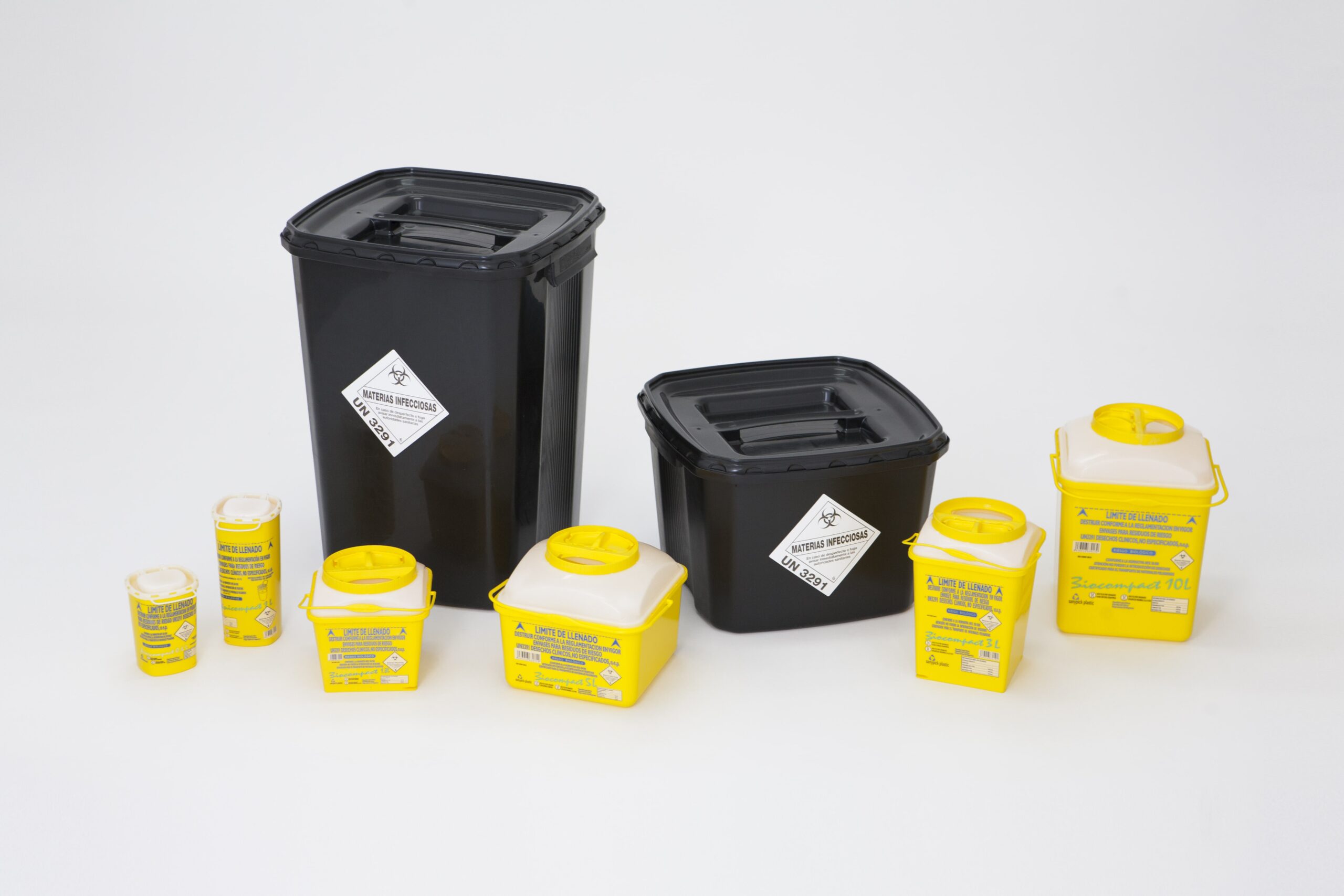Clinical Waste
At Urbaser we are pioneers in the responsible and advanced management of waste produced in healthcare settings.
Urbaser provides a comprehensive waste management solution designed to support healthcare facilities in the efficient handling of clinical waste. Our end-to-end service includes waste classification, staff training, and continuous support to ensure the safety of operations and full regulatory compliance.
At Urbaser we are pioneers in the responsible and advanced management of waste produced in healthcare settings.
The
Urbaser provides a comprehensive waste management solution designed to support healthcare facilities in the efficient handling of clinical waste. Our end-to-end service includes waste classification, staff training, and continuous support to ensure the safety of operations and full regulatory compliance.
Clinical waste encompasses a wide range of materials, each requiring specific protocols for identification, segregation, transport, treatment, and disposal. It is also referred to as waste with associated health risks.
Leveraging broad sector experience and national coverage, we are well-positioned to offer close and reliable support to our clients.
Healthcare waste management is typically categorised into two service scopes:
- Internal Management Performed within the healthcare facility itself. This includes identifying, segregating, and packaging different types of waste, as well as transporting it within the premises where it was generated.
- External Management This involves the collection, transportation, and final treatment of the generated waste. Final treatment methods vary depending on the type of waste and must comply with applicable legislation.


Sharps and Puncture Management
Sharps and puncture refer to items with pointed or sharp edges capable of piercing or cutting the skin. This includes medical devices such as needles and lancets. As sharps can cause injury and carry infection risk, it is critical that they are handled with strict safety protocols.
Classification of Hazardous Health Care Waste
Healthcare waste refers to any material or object arising from healthcare activities that the producer or holder either intends to discard or is obliged to manage as waste.
It is categorised based on its associated risk as either hazardous or non-hazardous.
Healthcare waste is classified based on its associated risk:
- Biohazardous Waste
- Special Bio-Healthcare Waste This category includes biohazardous waste that requires strict preventive measures during collection, storage, transport, treatment, and disposal, both within and outside the healthcare facility where it is generated, due to its potential risk to occupational and public health. This group of waste includes blood and blood products in liquid form; needles and sharps; live attenuated vaccines; anatomical waste; cultures and stocks of infectious agents; waste from research or experimental animals that have been biologically inoculated; among others
- Chemical Hazardous Waste
- Cytotoxic waste. This refers to waste containing substances that inhibit or prevent the development of neoplasms, limiting the growth and division of malignant cells by acting on specific phases of the cell cycle. As a result, these substances are themselves classified as carcinogenic, mutagenic, and/or teratogenic. This category includes:
- Residual cytotoxic drugs, vials with leftover or expired contents, and serum bottles with remaining solutions, typically resulting from changes in prescriptions, treatment cessation, incorrect preparation, etc.
- Sharp or puncture instruments used during the preparation or administration of these drugs
- Single-use medical devices that have come into contact with cytotoxic substances and retain traces, such as serum bottles, gauze, syringes, empty vials, etc.
- Traces of cytotoxic agents used in research laboratories (e.g., ethidium bromide gels)
- Waste Medicines. Waste of expired or out-of-use medicines.
- Chemical waste. These are wastes contaminated with chemical substances and classified as toxic and/or hazardous in accordance with Royal Decree 833/1988, which approves the Regulation for the implementation of Law 20/1986, the Basic Framework on Toxic and Hazardous Waste, and Royal Decree 952/1997 of 20 June, which amends it. They comprise a wide range of products generated primarily by clinical laboratories, pathology departments, and experimental laboratories.
What legislation applies to healthcare waste?
GOVERNING LEGISLATION FOR THE MANAGEMENT OF HEALTH CARE WASTE MANAGEMENT
Due to the specific characteristics of healthcare waste, its management is regulated and must comply with applicable legislation.
This regulatory framework varies between Autonomous Communities and is subject to ongoing development.
GOVERNING LEGISLATION
- Directive 75/442/EEC on waste and Article 1(4) of Directive 91/689/EEC on hazardous waste. Repealed by Directive 2006/12/EC.
- Law 22/2011 of 28 July on waste and contaminated soils
- Royal Decree 833/1988 of 20 July, approving the Regulation for the implementation of Law 20/1986 of 14 May 1986 on Basic Framework on Toxic and Hazardous Waste Amended by Law 25/2009 of 22 December, adapting various laws to the Law on free access to service activities and their exercise and modified by Royal Decree 1771/1994 and Royal Decree 952/1997.
- Royal Decree 952/1997 of 20 June, amending the Regulation for the implementation of Law 20/1986 of 14 May on Basic Framework on Toxic and Hazardous Waste approved by Royal Decree 833/1988 of 20 July
- Decree 283/1995 of 21 November, approving the waste regulations of the Autonomous Community of Andalusia Repealed by number 1 of the sole repealing provision of Decree 73/2012 of 20 March 2012, approving the Andalusian Waste Regulations
- Agreement of 14 June 2001 (Consejería de Medio Ambiente BOPA 7.7.2001), Basic Waste Management Plan for Asturias
- Order of 13 October 1989 (Ministry of Public Works and Town Planning) on methods of categorisation of toxic and hazardous waste (BOE No. 270, 10 November 1989).
- Decree 52/1998 of 24 February, of the Aragon Executive, amending Decree 29/1995 of 2 February on the management of health care waste.
- Decree 29/1995, of 2 February, of the Aragon Executive, on the management of health care waste.
- Decree 104/2002 of 26 July on the Regulation of Health Care Waste Management.
- Decree 136/1996 of 5 July, on the organisation of the management of health care waste in the Autonomous Community of the Balearic Islands.
- Decree 76/2002 of 26 March, regulating the conditions for the management of health care waste in the Autonomous Community of the Basque Country.
- Decree 51/1993 of 11 November on the organisation of health care waste management in the Autonomous Community of La Rioja.
- Decree 141/1998 of 1 December regulating the management, treatment and disposal of health care and biocontaminated waste in the Autonomous Community of Extremadura.
- Decree 68/2010, of 7 October, which regulates sanitary and similar waste in the Autonomous Community of Cantabria.
- Chartered Decree 296/1993 of 13 September, establishing the regulations for the management of health care waste in the Chartered Community of Navarre.
- Law 5/2003 of 20 March on waste in the Community of Madrid.
- Decree 83/1999 of 3 June regulating the production and management of bio-health and cytotoxic waste in the Community of Madrid.
- Legislative Decree 1/2009, of 21 July, approving the revised text of the Law regulating waste. This Royal Decree is amended by: Law 5/2012 of 20 March, on fiscal, financial and administrative measures and the creation of the Tax on Stays in Tourist Establishments
- Legislative Decree 1/2009, of 21 July, approving the revised text of the Law regulating waste. This Royal Decree was amended by Law 5/2012 of 20 March, on fiscal, financial and administrative measures and the creation of the Tax on Stays in Tourist Establishments
- Decree 27/1999 of 9 February on the management of health care waste in the Autonomous Community of Catalonia.
- Law 1/2013, of 21 May of the Valencian Community, on Measures for the Restructuring and Rationalisation of the Public Business and Foundation Sector of the Valencian Executive. Law 5/2013 of 23 December, on Fiscal, Administrative and Financial Management and Organisation Measures of the Valencian Executive.
- Decree 240/1994, of 22 November, of the Valencian Government, approving the regulations governing the management of health care waste. In force Decree 5/2011, of 3 February, amending various general provisions on health matters, to adapt them to Law 17/2009, of 23 November, on free access to service activities and their exercise and to Decree-Law 3/2009, of 23 December, on measures to promote service activities in Castilla y León.
- Decree 204/1994 of 15 September on the organisation of the management of health care waste in the Community of Castilla y León.
Should each waste-generating healthcare facility have an Internal Health Care Waste Management Plan? Who is responsible for submitting it?
Each facility must document every step involved in the management of its waste, from generation and packaging through to internal routing, intermediate storage, and final storage, prior to external handling.
A copy of this plan must be submitted to the relevant health authority in the corresponding Autonomous Community.
Specific requirements such as submission frequency, content structure, and other procedural details are outlined in the applicable regulations of each Autonomous Community.
Sedes de Soluciones Sanitarias
Mallorca (900 922 903)
Barcelona (900 922 903)
Cartagena CEE (900 922 903)
Vigo (900 922 903)
Las Palmas (900 922 903)
Madrid (900 922 903)
Málaga (900 922 903)
Sevilla (900 922 903)
Tarragona (900 922 903)
Tenerife (900 922 903)
Valencia (900 922 903)
Valladolid (900 922 903)
Vitoria (900 922 903)
Zaragoza (900 922 903)
